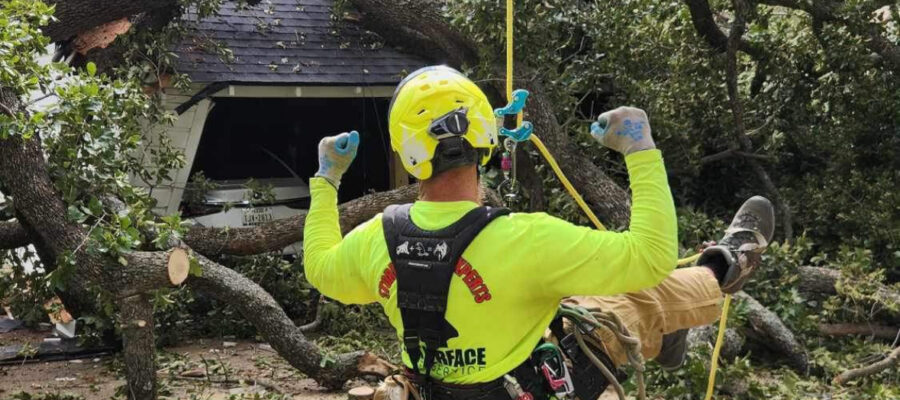Tree Removal: When is it Necessary?

Tree removal is a crucial aspect of arboriculture, ensuring the safety and well-being of both people and property. However, the decision to remove a tree should not be taken lightly. It requires careful consideration and assessment by ISA certified arborists who have expertise in tree health assessment, tree risk assessment, and tree evaluation. In this article, we will delve into the importance of tree inspections, who should be performing them, and how to find a reliable and affordable tree removal service near you.
The Importance of Tree Inspections
Before considering tree removal, it is essential to conduct a thorough inspection of the tree’s health and structural stability. A ISA certified arborist possesses the knowledge and expertise to evaluate trees and identify any potential risks or defects. Regular tree inspections can help detect early signs of decay, disease, or structural issues, allowing for appropriate interventions to be implemented to preserve the tree’s health for as long as possible.
During the inspection, the arborist will assess various factors, including:
–Tree Biomechanics: Understanding the mechanical properties of trees is crucial in evaluating their stability. Arborists consider aspects such as architecture, structure, decay, root characteristics, and wood properties to determine the overall health and strength of a tree.
–Structural Defects: Identifying and assessing structural defects is a key component of tree risk assessment. Arborists examine the tree’s trunk, branches, and root system to identify any weaknesses or abnormalities that may pose a risk of failure.
–Risk Assessment: Evaluating the potential risks associated with a tree is essential for ensuring the safety of nearby structures and individuals. Arborists consider factors such as the tree’s location, proximity to buildings or power lines, and the likelihood of falling branches or toppling over during severe weather conditions.
By conducting a comprehensive inspection, arborists can determine the best course of action for trees that may pose a risk to their surroundings.
When to Remove a Tree
Once a tree has been assessed and potential risks have been identified, the decision to remove it should be based on several factors, including:
–Irreversible Damage: If a tree has suffered irreversible damage due to disease, decay, or severe storm damage, removal may be the only viable option. In such cases, preserving the tree’s health becomes unfeasible, and its presence may pose a significant risk to its surroundings.
–Structural Instability: Trees with severe structural defects, such as large cavities, extensive decay, or compromised root systems, may become unstable and more susceptible to failure. In these instances, removal is often the safest solution to prevent potential accidents or property damage.
–Limited Space: In urban environments where space is limited, trees that have outgrown their surroundings and pose a risk to nearby structures or power lines may need to be removed. This ensures the safety of both the tree and its surroundings.
–Diseased Trees: Trees affected by incurable diseases, such as Dutch elm disease or oak wilt, may need to be removed to prevent the spread of the disease to other healthy trees in the vicinity.
It is crucial to consult with a certified arborist to determine the appropriate course of action for each specific tree, as removal should always be considered a last resort.
Finding a Reliable and Affordable Tree Removal Service
When it comes to tree removal, it is essential to hire a reputable and experienced tree removal service. Here are some steps to find an affordable and reliable service near you:
–Research Local Tree Removal Services: Start by researching local tree removal services in your area. Look for companies with a strong reputation, positive customer reviews, and a track record of professional tree removal services.
–Check for Certification: Ensure that the tree removal service you choose employs ISA certified arborists. Certification from reputable organizations, such as the International Society of Arboriculture (ISA), indicates that the arborists have undergone rigorous training and adhere to industry standards.
–Get Multiple Quotes: Obtain quotes from several tree removal services to compare prices and services offered. This will help you find an affordable option without compromising on quality and professionalism.
–Ask for References: Request references from past clients to gauge the quality of work provided by the tree removal service. Speaking with previous customers can give you valuable insights into the company’s reliability, efficiency, and customer satisfaction.
–Insurance Coverage: Ensure that the tree removal service you choose has appropriate insurance coverage. This protects you from liability in case of any accidents or property damage during the tree removal process.
By following these steps and conducting thorough research, you can find a reliable and affordable tree removal service that meets your needs.
Conclusion
Tree risk assessments require careful consideration and assessment by certified arborists. Through thorough inspections, arborists can identify potential risks, assess the tree’s health and structural stability, and help you make informed decisions regarding whether removal is necessary. By finding a reputable and affordable tree removal service, you can ensure the safe and efficient removal of trees that pose a risk to their surroundings. Remember to consult with certified arborists, obtain multiple quotes, and prioritize professionalism and quality when selecting a tree removal service near you.
Additional Information: It is important to note that tree removal should always be considered as a last resort. Arborists strive to preserve and protect trees whenever possible, as they provide numerous benefits to the environment and contribute to the overall beauty and well-being of our surroundings.
